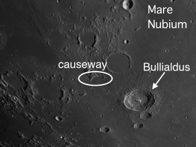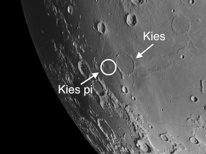The week of February 3-9 takes us from Day 9 to Day 15. This week we will highlight the Bullialdus Causeway and the lunar dome Kies (Pi), viewable Monday night.
 Bullialdus Causeway1: [SW/M7] There is a wide, shallow valley that extends out from the west rim of Bullialdus and travels NW towards the crater Lubiniezky. Toward the end of the valley (a little more than one crater diameter) you will run into two parallel lines, about 7 miles apart, running perpendicularly across the valley. These parallel lines are clearly depicted on the Field Map as a short arc and give the illusion of a causeway or a bridge that cuts across the valley at right angles. (You’ll need about 150x.) Whatever it is, it remains something of a mystery, and nobody has come up with an adequate explanation.
Bullialdus Causeway1: [SW/M7] There is a wide, shallow valley that extends out from the west rim of Bullialdus and travels NW towards the crater Lubiniezky. Toward the end of the valley (a little more than one crater diameter) you will run into two parallel lines, about 7 miles apart, running perpendicularly across the valley. These parallel lines are clearly depicted on the Field Map as a short arc and give the illusion of a causeway or a bridge that cuts across the valley at right angles. (You’ll need about 150x.) Whatever it is, it remains something of a mystery, and nobody has come up with an adequate explanation.
 Kies (Π) Pi: [SW/M7] Sandwiched in between Bullialdus and Rima Hesiodus you will find one of the Moon’s best examples of a lunar dome, Kies (Π). Being located below the conspicuous crater Bullialdus and just west of the flooded crater Kies, it is one of the easiest domes to find. It is 7 miles in diameter, but because it is only 500 feet high you must catch it under a very low Sun, which will be the case Monday night. With luck, good optics, and a steady atmosphere you might be able to make out the 0.8 mile summit pit at the top. Most lunar domes occur in groups, so Kies (Π) is something of an oddity.
Kies (Π) Pi: [SW/M7] Sandwiched in between Bullialdus and Rima Hesiodus you will find one of the Moon’s best examples of a lunar dome, Kies (Π). Being located below the conspicuous crater Bullialdus and just west of the flooded crater Kies, it is one of the easiest domes to find. It is 7 miles in diameter, but because it is only 500 feet high you must catch it under a very low Sun, which will be the case Monday night. With luck, good optics, and a steady atmosphere you might be able to make out the 0.8 mile summit pit at the top. Most lunar domes occur in groups, so Kies (Π) is something of an oddity.
1 This is a purely descriptive term as there is no official name for this feature.
======================
It is highly recommended that you get a copy of Sky and Telescope’s Field Map of the Moon, the very finest Moon map available for use at the telescope. It is available for $10.95 at www.skyandtelescope.com and on Amazon. All features mentioned in this blog will be keyed to the grid on the Field Map and will look like this: Plato: [NW/D9]
Credits:
Courtesy of Gray Photography of Corpus Christi, Texas
Lunar photos: NASA / USGS / BMDO / LROC / ASU / DLR / LOLA / Moon Globe. Used by permission
- Rupes Cauchy: A Best Known Fault on the Moon - July 22, 2024
- Moon Crater Schickard – Crater Floor has Stripes - July 15, 2024
- Moon Craters Langrenus and Vandelinus - July 8, 2024